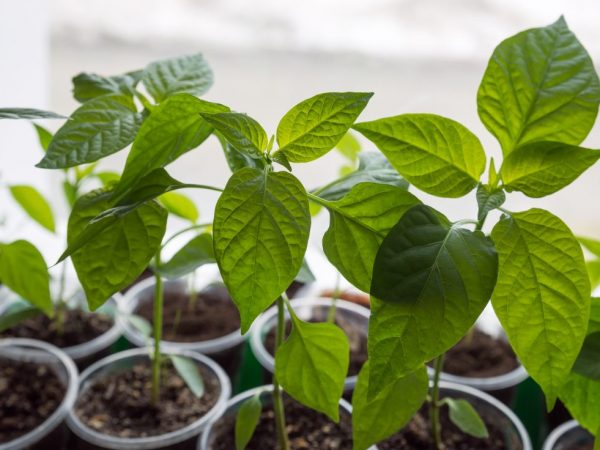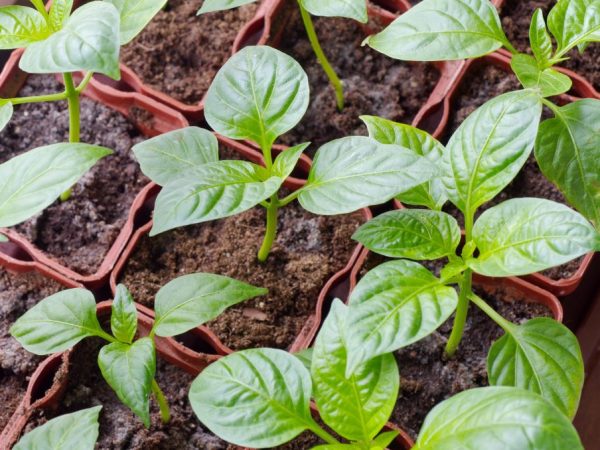For what reasons, pepper seedlings grow poorly
If the seedlings of peppers do not grow well, this may be the result of many factors. It is necessary to find the cause and immediately begin to eliminate it. Let's consider what needs to be done to avoid such a problem.

Pepper seedlings grow poorly
Causes
Pepper seedlings do not grow for many reasons. Most often, the rules of planting care are violated. In order for the plant to grow and develop correctly, you need to provide it with nutrients, as well as timely watering, weeding and processing from pests. One minor mistake during the seed planting phase can significantly reduce yields and cause Poor Growth.
Errors in the preparation of planting material
Immediately you need to competently and seriously approach the choice of soil and seeds. First you need to select and prepare planting material. You can buy your favorite pepper variety in the store, or you can collect the seeds yourself.
It must be remembered that the seeds of hybrids do not retain varietal characteristics, and how the bush will grow, one cannot know for sure. Sometimes this is what causes poor growth. Don't plant old seeds. The manufacturer indicates their expiration date on the pack.
To make sure the seeds are good, they need to be placed in a salty solution. Approximately 4 tbsp. l. for 1 liter. water. When they get wet (after 15-20 minutes), empty seeds will rise to the surface of the water, and those suitable for planting will fall to the bottom.
Then you need to germinate the already selected pepper seeds. To do this, they are placed in a saucer or plate, with cotton or gauze previously moistened in it. Care must be taken to ensure that the grains do not float, but are simply moist enough. If, despite the fact that this procedure was carried out, and the seedlings of peppers still grow poorly, then the reason is poor-quality seeds.
Poor quality soil
In order for the seedlings to grow well and quickly, and the seeds to sprout faster, you need to know some features of the soil. The soil in the garden around the house may not be the most favorable for growth. It is recommended to use a commercially available planting mixture or prepare the soil yourself.
Soil preparation rules:
- The soil should be loose, moisture permeable. Loam can be mixed with very fine sand.
- Compost or humus should be added to the soil to improve its organic composition. Any plant matter will also work, but don't use herbs with seeds.
- Check the acidity of the soil. The PH level should be 6-6.5, since pepper seedlings do not grow in an acidic environment.
You can collect soil from your garden before winter begins by pouring it into buckets or bags. And then leave to freeze on the balcony or in other cold places. In such soil, the seedlings will feel much better, since all unnecessary bacteria and larvae will die.
But what you shouldn't do is expose the earth to high temperatures. Microbes will evaporate, but along with them all useful substances will disappear. After that, the seedlings grow much worse.
Mistakes when growing seedlings

Excessive watering can harm seedlings
It is advisable to plant pepper seeds in late February or early March. Everything directly depends on the variety and ripening time. You need to pay attention to the description and recommendations on the back of the seed bag.
It is advisable to prepare and water the soil the day before planting. The ground should not be very wet. Otherwise, the shoots will turn sour and grow poorly. After that, small indentations are made, about 0.5 cm and at a distance of 2 to 4 cm. apart.
Saplings grow poorly, which are interfered with by neighbors. It is advisable to take a rather large capacity for seedlings so that the root system has room to develop.
Planting peppers on seedlings too early leads to overgrowth of seedlings. Such plants take longer to take root in a new place worse and longer. This leads to the fact that the seedlings of peppers begin to lag behind in development, and later enter into fruiting.
Pick errors
When about 2 weeks have passed since the planting of the seeds, and the plant has 2 true leaves, a pick is carried out. If the seedlings initially grow in individual containers, then they do not need this procedure.
Without a pick, the plantings become too thick and, as they grow, begin to shade each other. Such plants grow and develop poorly due to lack of space.
To begin with, the seedlings are watered with water and given time to absorb. Then, very carefully, so as not to damage the delicate root system, the seedlings are taken out. Transplanted peppers grow better if they are immediately taken out to a bright and warm place.
Picking involves pinching the main root of the plant. If too much is removed, the pepper seedlings will stop growing and may even die. After transplanting, the earth is well tamped to remove possible air pockets in the pot. Because of this, plants can also slow down their growth.
Lack of food
Pepper seedlings grow poorly with a lack of nutrients in the ground. Poor soil is not the best option for growing this crop. Even if the peppers have sprung up, their normal development and fruiting remains in question.
For the full growth and development of pepper, you need to adhere to some feeding rules:
- If the pepper seedlings die or the leaves turn yellow, magnesium fertilization is urgently needed.
- There is not enough nitrogen - the plant withers and takes on a yellowish tint.
- Top dressing with potassium. Potassium is responsible for the terrestrial part of the plant, which guarantees a good harvest.
- After the first leaves appear, it is advisable to apply fertilizer with a high phosphorus content.
An excellent organic fertilizer option is herbal infusion. It helps to speed up the growth of the pepper immediately after replanting it to its permanent location. To make the solution, weeds are collected without seeds. It is cut finely, placed in a container and filled with water. After 2 weeks, fermentation stops and you can add liquid right under the root of each bush.
They also resort to foliar feeding. This method is effective during the period of ovary formation, as well as after the first harvest. To obtain a solution, mix milk whey, a few drops of iodine and 1 teaspoon of boric acid. Processing should be carried out in dry weather so that the fertilizer is not washed off by precipitation. The optimal time for foliar feeding is in the evening or earlier in the morning.
Conclusion
If you follow all the requirements for caring for pepper, then the seedlings will grow well and bear fruit. Otherwise, the bushes may stop at one stage and stop growing.


